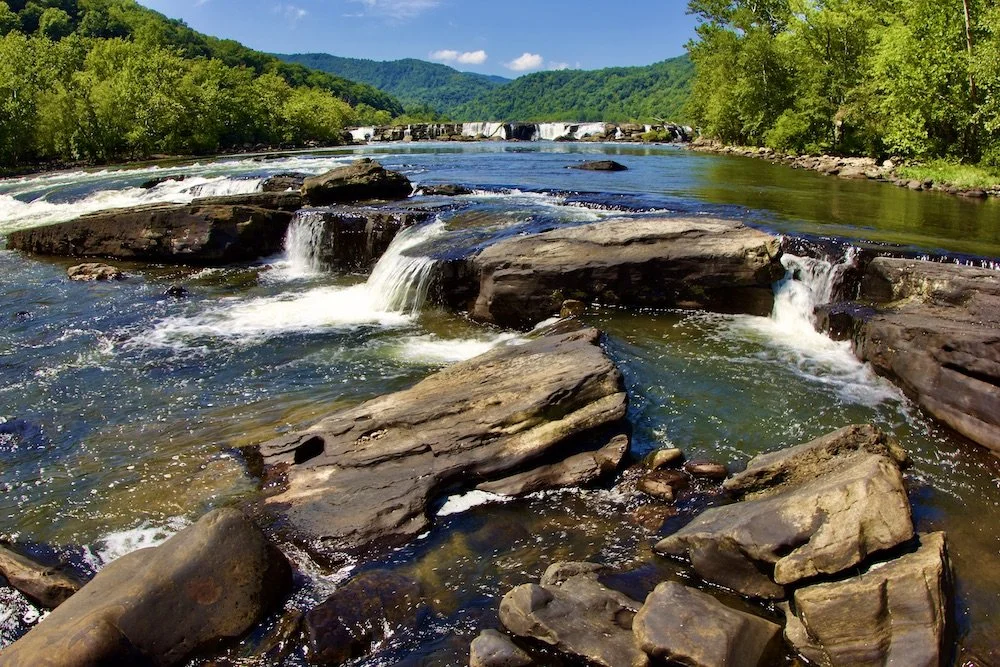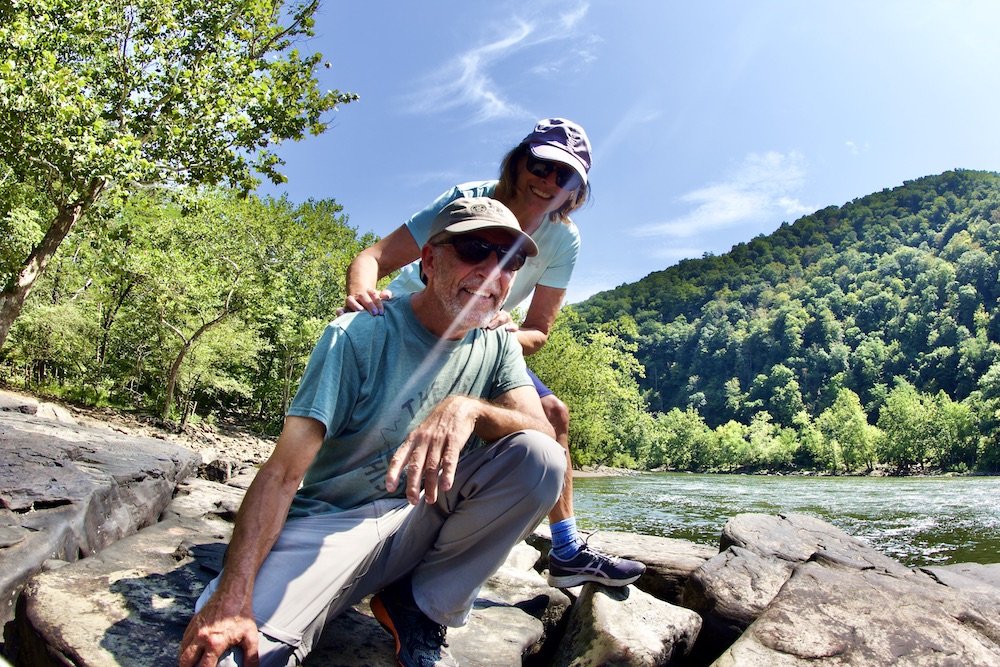Traveling America By Van: Next Stop, New River
By: John Kumiski
We were flying south through Ohio on interstate 77, mileage mode having taken over. Look, there's the Pro Football Hall of Fame! Susan yawned, uninterested. No stop. I suspect I could spend hours there.
The hills in southeastern Ohio were unexpected. We crossed the terminal moraine left by the last glacial advance shortly after passing Canton. Without the grinding action of the glaciers, the topography was relatively unaffected. The soils and groundwater were not affected either. The glaciated part of Ohio now produces the vast majority of the state's agricultural output. The soils in southeastern Ohio are poor, the groundwater sparse. Great for recreation, bad for farming. But you find coal here. The extensive coal seams reach deep into West Virginia.
If you could go back in time 300 million years (seems like a long time, but as earth's history goes it's still reasonably recent) and visit this area, you might find it hard to recognize. To the west was an enormous shallow sea. Around you, you'd see a dense, tropical jungle, marshy, swampy. The equator ran through nearby. A riotous profusion of plants lived and died here, then fell into the swamp. Low oxygen levels prevented decomposition. The dead plant materials piled up, getting thicker, and thicker. Eventually there were thousands of vertical feet of it.
One of the crises of our time is global warming. It's not a new phenomenon. Those ancient seas rose, for millions of years flooding those dead plants and depositing similarly thick layers of calcium-rich shell and ooze on top of them. Then the sea level dropped again, and back came the jungle. This process repeated multiple times.
To the east, mountains rose. Mountains weather and erode, and streams carry enormous loads of sediment. The layers of plant material and calcareous deposits were deeply buried, and subjected to tremendous pressure and heat. The plant material became coal. The calcium deposits became limestone.
In southeastern Ohio and most of West Virginia, the parent rock is mostly limestone. When the interstates were being built, blasting through the rock for roadways revealed rich seams of coal. Of course, coal had already been mined here for decades already, anyway. Its presence was hardly a secret. Coal mining was the major economic driver in most of West Virginia, having supported generations of West Virginia families. Coal is still being mined there. We saw miles long trains consisting only of locomotives and hopper cars, all filled to the brim with shiny black rock.
All that having been said, we did not stop for recreation, or to dig any coal. Our goal was Babcock State Park in West Virginia. That goal required serious driving, none of the stop-and-smell-the-roses kind of driving we'd done so much of out west. We intended to spend a couple days exploring the New River Gorge National Park before heading to North Carolina. Babcock would be our base.
We drove past Charleston, then exited the interstate, getting on to US 60. Here was a mountain road! The mountains weren't high, but they were steep, and the road went up and down, and left and right, and back and forth, snaking through the hills to and through little towns that looked like they had seen better days, past railyards with trains filled with coal. There were nice views, and some not-so-nice ones. There weren't a lot of places to stop, get out, and enjoy the nice ones. Besides, I wanted to get to the park. It had been a long day.
A backwater area of the New River, near Sandstone Falls.
Babcock State Park was a lovely property. After we got situated we wanted to walk. The park had trails, and we took one. We didn't have a map. We didn't care. An out-and-back of a couple miles would be plenty. We just needed to move after sitting all day.
Our main reason for visiting West Virginia was to see North America's oldest river, the New. Some geologists peg the New River at about 300 million years. Others choose a more conservative 10 million. Since rivers are always temporary landscape features, we find either estimate impressive.
Some geologists believe that the New River was flowing in more-or-less its current position when the Appalachian Mountains started to rise. From the website - "Prior to the rise of the Appalachian Mountains, the New River cut its bed at a time when the land sloped to the northwest. Amazingly so, as the Appalachians gradually rose around the river, the New River wore away the bedrock at the same rate the mountains formed, leaving behind towering cliffs and prominences that hover hundreds of feet about the water level."
From the same website- "Class I, II, and III rapids dot the entire 37 miles of New River in Giles County, making it a great paddling adventure, while beautiful cliffs, bluffs, and mountain views make it one of the most scenic rivers on the east coast. In 1998, because of historical, economical, and cultural importance, President Clinton signed into law the New River as one of the very first American Heritage Rivers."
Much of the New River watershed was protected as the New River Gorge National River back when Jimmy Carter was president. In 2020, this area was redesignated as the New River Gorge National Park and Preserve. It's one of the country's newest national parks! And this was the main reason we came to West Virginia, to visit the river, see the sights, maybe do a little hiking and fishing.
We visited the national park Visitor Center. The center houses an impressive series of displays on the history, biology, and geology of the river basin, where we learned a lot about the river. But when I asked the ranger where to get a cup of coffee, he couldn't tell me. Our exploration of the river basin was somewhat put on hold while we searched for a simple cup of joe.
Our search led us to the town of Hinton. You'll find a Tourist Information Center there. The women working there were very nice. Now it was lunch time, and we asked about getting lunch. They couldn't tell us. There were no open restaurants in town, due to the pandemic.
Even without coffee, we were still smiling! At Sandstone Falls.
We went to visit Sandstone Falls, where a boardwalk leads out to the river. We explored a bit here, and took some photos. We also discussed what to do with the rest of the time we had intended to spend here. Susan said, "I think we need to leave West Virginia. No coffee, no restaurants..." One of the reasons we've been married so long is that when my wife says things like this, I don't argue. I just do it. After we finished our picnic at Sandstone Falls, we got in the van, got on Highway 20, and headed for North Carolina, hoping to find some coffee and a restaurant along the way.
In a way, it's sad we left from a place we wanted to explore over something as trivial as a cup of coffee. On the other hand, a place that supposedly caters to tourists needs to have some infrastructure to, you know, actually do the catering. In our defense (not that we need any defense), we may have been getting tired of traveling. We'd left home in March, it was now August. We would visit our friends in North Carolina, and see what form the end of our journey would take.
Have you done something interesting outdoors? Join Global Outdoors and write a review to tell everyone about it! We’re building the home for trusted reviews of outdoor experiences, outfitters, and guides.




